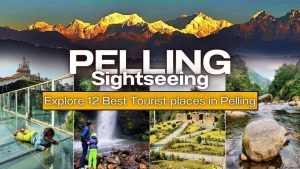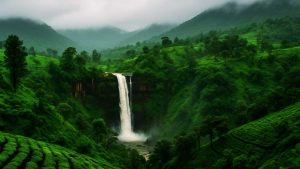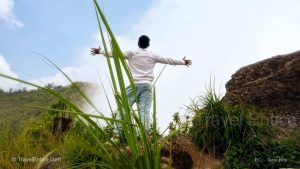Santiniketan, the land of Kabiguru, is more than just a tourist destination—it is a timeless emotion for Bengalis and a living testament to Bengal’s cultural heritage. Famous as the home of Nobel laureate Bishwakabi Rabindranath Tagore and the prestigious Visva-Bharati University, this quaint town in Birbhum district (West Bengal) blends art, science, literature, and nature into one soulful experience. Whether you’re exploring the place for the first time or a returning visitor to relive its charm, a well-crafted Santiniketan tour plan can make all the difference in capturing its true essence.
From the golden sunlight filtering through Sonajhuri forests to the heartfelt melodies of Baul singers, from strolling around UNESCO-listed heritage buildings to finding peace by the serene Kopai River—Santiniketan invites you to slow down, connect with nature, and immerse yourself in culture.
This detailed Santiniketan tour plan is curated by two Santiniketanists (Dr. SD & Ms SD) who have lived here for over 20 years. It covers a perfect 3-day itinerary with the best places to visit, cultural highlights, travel routes, stay options, and insider tips—everything you need to make your trip memorable.
Table of Contents
Santiniketan: A Brief Introduction
The name “Santiniketan” translates to “abode of peace”, and that is exactly what this unique village-town offers—tranquil landscapes, tree-lined pathways, and a slower rhythm of life far removed from the chaos of cities. From the golden glow of Sonajhuri Forest to the vibrant intellectual atmosphere of Visva-Bharati University, every corner of Santiniketan carries a story of nature, culture, and education.
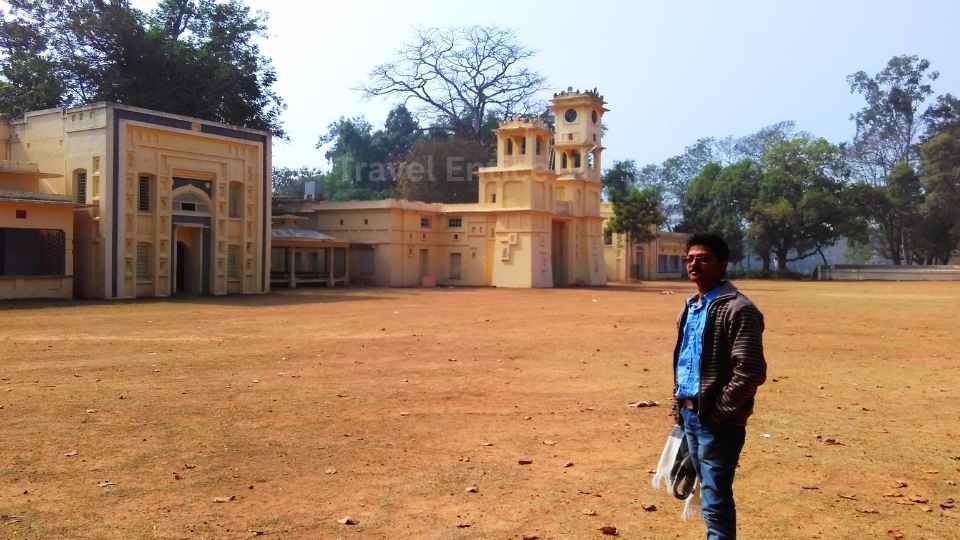
Top Tourist Attractions in Santiniketan
Santiniketan is a perfect blend of study, culture, nature, and history, offering something for every kind of traveler. Here is the list of things to do in Santiniketan and must-visit places to include in your Santiniketan tour plan:
| Things to do | Description |
|---|---|
| Visva-Bharati Campus Tour | Explore the vast campus of Visva-Bharati University, founded by Rabindranath Tagore, where open-air classes, sculptures, and murals blend seamlessly with nature. |
| Uttarayan | You can see Tagore’s manuscripts, letters, paintings, and personal items at Rabindra Museum . Just next door, the Uttarayan Complex houses the five distinct homes where Tagore lived and penned some of his greatest works. |
| Sriniketan | Not popular among tourists, Sriniketan, the rural development wing, showcases handicrafts, pottery, and rural upliftment projects (including the renowned Agriculture department of Visva Bharati). |
| Sonajhuri Forest | Walk through the golden glow of Sonajhuri and enjoy the lively weekend market filled with handicrafts, folk music, and local delicacies. |
| Kopai River | Take a leisurely walk along the Kopai River, soaking in the rural charm and the beauty of the Kopai River. |
| Deer Park | A peaceful escape into nature where you can spot spotted deer herds and migratory birds. Ideal for photography and a short morning trip. |
| Prakriti Bhavana | A unique museum showcasing stunning sculptures — actually, those are dead parts of trees and natural rock formations—perfect for art and photography lovers. |
| Amar Kutir | A famous cooperative society where you can shop for leather goods, hand-crafted sarees, batik prints, and more, supporting local artisans. |
| Kankalitala Temple | One of the 51 Shakti Peethas, this sacred temple attracts local pilgrims year-round. Located a short drive from Santiniketan, it’s a great blend of spirituality and pure nature. |
| Shopping in Santiniketan | Beyond the haats, visit local shops for authentic handicrafts, batik and kantha-stitch clothing, dokra jewellery, leather bags, and home décor items. |
Related: Mousuni Island – uncover the hidden gem in South Bengal
Day-Wise Santiniketan Tour Plan
Whether you have just a weekend or a few leisurely days, this itinerary will help you soak in the essence of Santiniketan—its serene landscapes, Tagore’s legacy, vibrant art scene, and soulful rural charm. From tranquil mornings under Sonajhuri trees to exploring heritage campuses and bustling haats, each day blends culture, nature, and authentic Bengali experiences.
Day 1: Arrival & Immersing in Local Ambience
- Reach Santiniketan
- Check in to Hotel
- Visit Goyalpara/Sonajhuri
Arrive in Bolpur by train or car and check into your preferred accommodation. For a peaceful, authentic stay, choose Sonajhuri, Goyalpara, Ballavpur, or Prantik—these areas are green, quiet, and close to major attractions.
If you’re arriving by Santiniketan Express or Kabiguru Express, it’ll be close to lunchtime. A lunch classic option is Mahamaya Hotel near the railway station—one of Bolpur’s oldest eateries, serving homely Bengali meals at very reasonable prices. If you arrive earlier (via Ganadevata Express), you could try lunch at your hotel’s restaurant or somewhere around (List of restaurants given below).
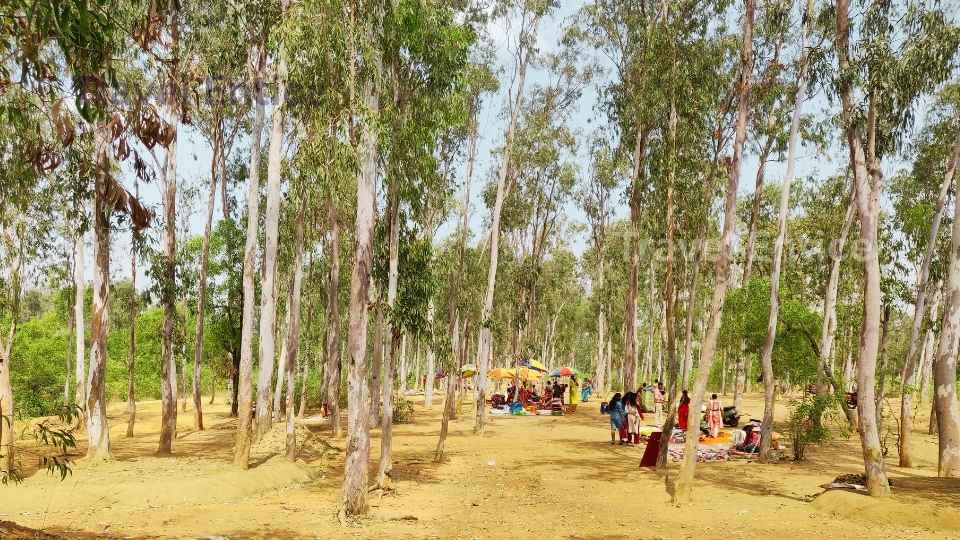
After lunch, ease into Santiniketan’s slow, welcoming rhythm:
- If staying near Sonajhuri: Take a gentle walk through the Sonajhuri tree-lined paths. If it’s Saturday, visit Sonajhuri Haat, a lively open-air market where artisans sell handwoven fabrics, embroidery works, jewellery, and décor. Baul musicians fill the air with soulful tunes.
- If staying near Goyalpara: Stroll at the bank of Kopai River for serene views and sandy banks; return before daylight is down.
In the evening, wander through Ratanpalli for a charming feel and enjoy snacks before ending the day.
Related: Joychandi Pahar – Enjoy a perfect weekend exploring the beauty of Rahr Bengal
Day 2: Tagore’s Santiniketan & Campus Heritage
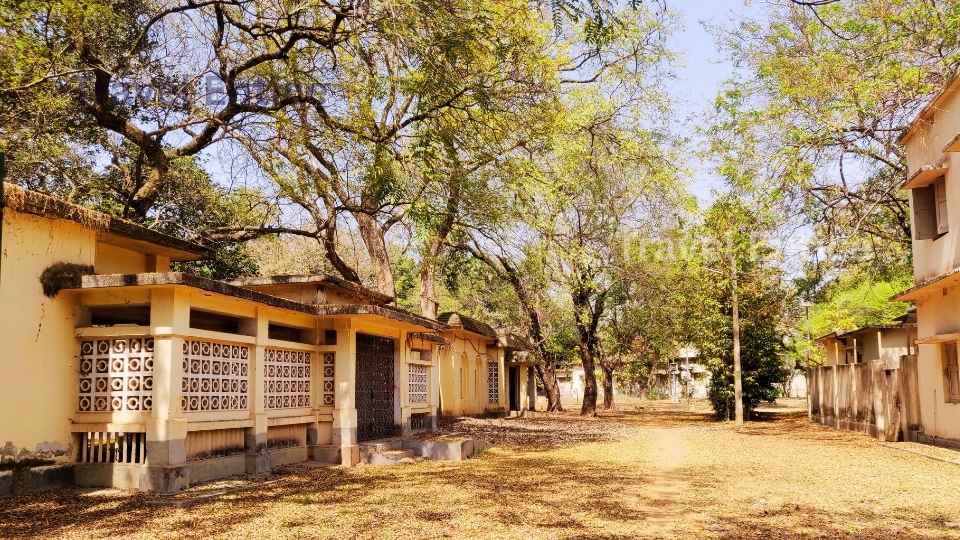
- Sonajhuri Morning trip
- Rabindra Musium
- Visva-Bharati Campus Tour
- Deer Park
- Sonajhuri Haat/Goyalpara
- Nakshi Kantha Boutique Tour
Start your morning with the magical Sonajhuri Goldenglow (6–9 AM). The golden sunlight filtering through tall trees, the calm canal waters, and the early-morning birdsong create a peaceful, picture-perfect scene. Visit nearby villages to see rural life, and stop by the small art shop of a former Kala-Bhavana student, situated in the village.
After breakfast, hire a Toto or a car for your Heritage Tour. Explore the following here:
| Uttarayan Complex | Explore Tagore’s residences—Udayan, Konarka, Shyamali—and see his manuscripts, photographs, and personal items. |
| Upasana Griha | The prayer hall (Locally known as Kanch Mandir) with walls made from Belgian glass that glitters in sunlight. |
| Visva-Bharati Campus Tour | See the open-air classrooms of Patha-Bhavana under ancient trees, UNESCO-listed heritage sites like Singha-Sadana and Ghantatara, and the peaceful spots of Amrakunja, Tin-pahar, and Chhatimtala. If you have time in hand, visit Sriniketan after lunch, covering the deer park, and witness rural development initiatives and traditional craft learning centers. (Note: Some Heritage areas now require special entry permission.) |
| Kala-Bhavana | Explore the world-renowned fine arts institute showcasing murals, sculptures, and artworks by great masters and students. |
Lunch Tip: Try a Bengali thali at nearby Kasahara (Sripalli, near Kala-Sangit Bhavana), Kiranmala (Lalbandh), or Ramshyam Restaurant (Sonajhuri).
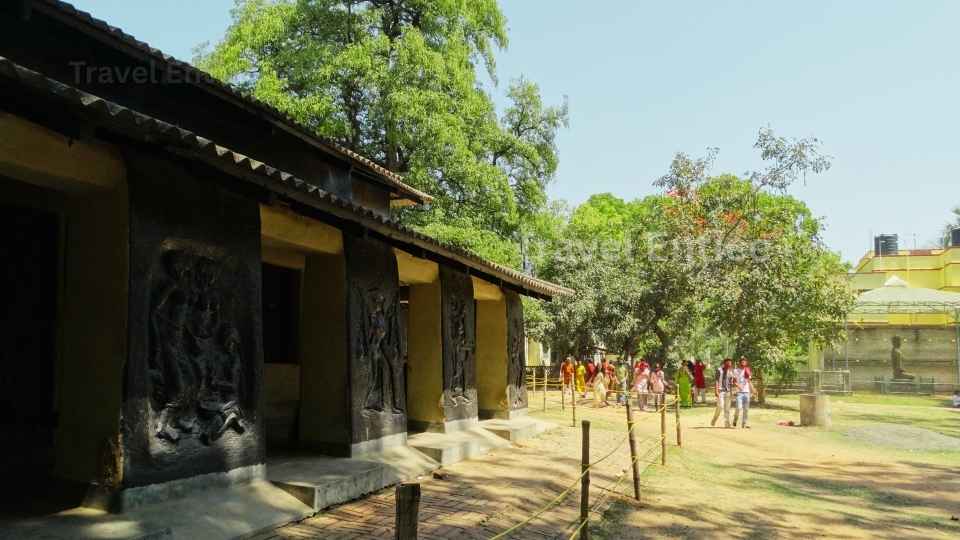
In afternoon, visit Deer Park near Siksha-Bhavana (The Institute of Science). Spread over lush green land, it is home to numerous deer. Last your visit up to around 3:30-4 PM to see them gather at the salt pit—a lovely sight for wild lovers.
Evening Options:
- Visit Sonajhuri Haat (if you missed it on Day 1).
- Explore the Kopai River at Goyalpara (if you missed it on Day 1).
- Go Kantha shopping at Tania’s Nakshi Kantha Boutique (45-Pally), offering exquisite hand-stitched sarees, batik work, hand-painted silks, scarves, punjabis, and stoles.
Note about Tania’s Nakshi Kantha Boutique: You can visit there anytime between 10 AM and 8 PM. Tania, a former student of Visva-Bharati University (Class II – B.A) and a fashion technology graduate, curates an exclusive collection of hand Kantha-stitched sarees, Batik designs, hand-painted pure silks, Gujarati-stitched pieces, scarves, stoles, punjabis, and more—the exclusive collection you won’t find elsewhere. Saree price range varies from 4500-15000 based on silk quality and stitch/print style, and quality (Contact / Whatsapp 9933549474).
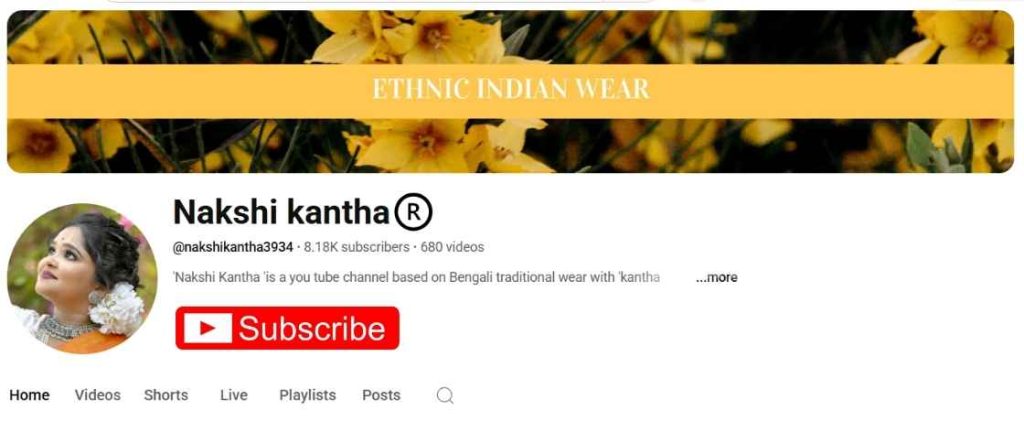
Related: Plan a trip to Jaldapara and explore the Indian one-horned rhinoceros
Day 3: Nature, Crafts & Farewell
- Kankalitala Mandir
- Prakriti Bhavana at Sonajhuri
- Amar Kutir
- Tania’s Nakshi Kantha Boutique Tour (if missed last evening)
- Return
Begin your last day with a visit to Kankalitala Mandir, one of the 51 Shakti Peethas. Located beside the Brahmani River, it offers a peaceful, spiritual atmosphere. Offer prayers and enjoy the quiet riverside before heading back.
After breakfast, head to Prakriti Bhavana at Sonajhuri—a unique nature museum where tree trunks resemble animals, stones look like humans, and other natural objects mimic works of art.
Follow the same route towards Ballavpur, and stop at Amar Kutir, a cooperative selling leather goods, bamboo crafts, handwoven shawls, and local handicrafts.
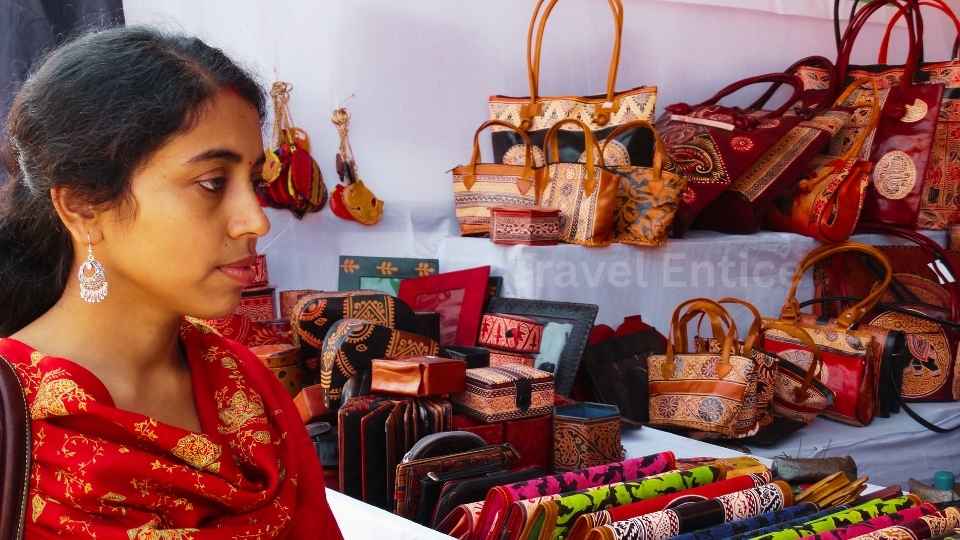
You can take lunch at Hensel Ghar (Amar Kutir), Bansuri, Kharimati, Mohor Kutir, or Athenaeum Greens.
If you missed Tania’s Nakshi Kantha boutique the previous evening, you may visit there anytime on your final day, maybe after lunch if you have enough time.
Return Tips: Book the Saheed Express or Ganadevata Express for a late-evening departure so that you can enjoy Day 3 fully. However, if you still feel too lazy to say goodbye, stay another night and return the next morning via Visva-Bharati Fast Passenger and join the office directly.
Related: Ranchi Tour Plan – Explore Forest, Hills, Rivers, and Waterfalls Altogether
How to Reach Santiniketan
Santiniketan is easily accessible by rail and road:
- By Train: The most convenient options from Kolkata are Santiniketan Express, Ganadevata Express, Maa Tara Express, Saheed Express, and Visva-Bharati Fast Passenger. However, there are many other options, because all trains destined to North Bengal or the North-East (via Barddhaman-Rampurhat route) stop at Bolpur Shantiniketan Station.
- By Road: A private car journey (approx. 4–5 hours) via NH2 offers flexibility and a scenic countryside drive through Panagarh and Ilambazar.
Travel Tip: If you want to explore nearby villages, the Kopai River, and less crowded areas at your own pace, self-driving or hiring a car is the best choice.
Related: Kurseong Sightseeing – Best Places to visit in Kurseong
Best Time to Visit Santiniketan
While Santiniketan is enchanting year-round, each season has its own charm:
- Winter (November–February) – Crisp air, clear skies, and major cultural events like Poush Mela and Joydev Mela. This is peak tourist season.
- Spring (March) – The vibrant Basanta Utsav (Holi) fills the campus with colours, music, and dance—an unforgettable celebration.
- Monsoon (July–September) – Lush greenery, the rhythmic sound of rain on tin roofs, and a romantic, tranquil vibe. Perfect for couples and nature lovers.
If you want to feel the true vibe of Santiniketan, I recommend you avoid festive times or long weekends. In festive times, Santiniketan becomes overwhelmed with tourist rush, ruining its real beauty. Also, hotel and local transport prices remain very high. You should avoid the Summer trip (April–June) to Santiniketan, as it remains extremely Hot during this season.
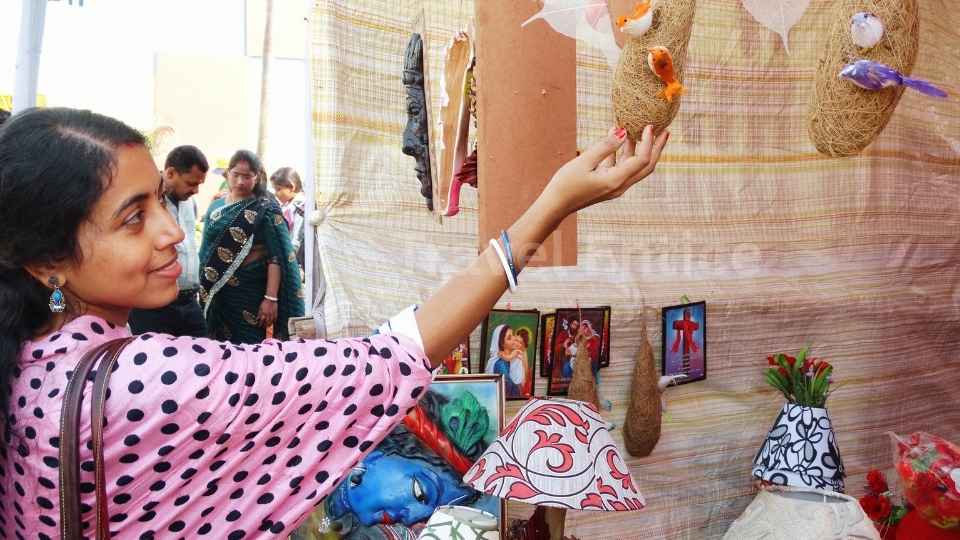
Best Hotels in Santiniketan
Santiniketan offers accommodation for every budget and taste: Below is a long list of good hotels and resorts in Santiniketan. Note: All the hotels listed below are situated away from crowd, where you can feel the natural charm, at Shyambati area, Goyalpara route, Sonajhuri and Ballavpur area. You can get more budget hotels in Bolpur side.
| Budget Hotels & Homestays | Mid-budget & Premium Stays |
|---|---|
| Tanubithi Resort – Amar Kutir Rd (4.6/5) | Mohor Kutir – Ballavpur (4.6/5) |
| Panchobon Resort – Taltore, Sayarbithi Park (4.3/5) | Mayabon Resort – Uttar pally, Goalpara (4.7/5) |
| Khoai Village Resort – Kasba Rd, Goalpara (4.4/5) | The Creek – Shankar Rd, Bayradihi (4.4/5) |
| Mohor Bari Homestay – Purbapally (4.9/5) | Mohul – Prantik (4.9/5) |
| Aayna Homestay – Ayna Bari Rd, Ratanpalli (4.8/5) | Santiniketan Retreat Dreamland, Shyambati (4.5/5) |
| Aparajita Homestay – Purbapally (4.6/5) | Sonajhurir Adda – Ballavpur – Near Khoai Hut (4.5/5) |
| Mrigana – Deer Park, near Siksha-Bhavana (4.3/5) | The Mud House – Ratanpally (4.2/5) |
| Guloncho Homestay – Andrews Palli (4.4/5) | Baine Resort – Shankar Rd, Prantik (4.2/5) |
| Park Guest House – Deer Park, Laal Bandh (3.8/5) | Amoli – Ratan Pally (4.1/5) |
| Mayas – Ruppur (4.4/5) | Raktokorobi Karugram – Rooppur, Binuria (4.4/5) |
| Karatoya – Ratanpalli (4.4/5) | Chuti Holiday Resort – Charupally Rd, Bolpur (4.1/5) |
| Nibhṛite Yatane – Kheledanga, Ballavpur (4.9/5) |
Note: During peak seasons (Poushmela & Basantotsav – Dol), the hotel prices hike remarkably (more than twice).
Best Restaurants in Santiniketan
Santiniketan offers a Bengali, tribal, and continental flavours:
- Ghure Asun Restaurant – Known for authentic Bengali meals.
- Handpicked by Amrita (pre-order)
- Ramshyam Restaurant (Sonajhuri) – Great for homestyle cooking.
- Kharimati Restaurant & Bar– All types of food and drinks
- The Garden Restaurant – Relaxed dining in a green setting.
- Hensel Ghar (Amar Kutir)
- Bansuri
- Mohor Kutir
- Athenaeum Greens
- Mahamaya (Near Bolpur Station)
Food Tip: Try local favourites like posto-bora (poppy seed fritters), shorshe ilish (hilsa in mustard sauce), and mochar ghonto (banana flower curry).
Related: Plan A Memorable Tinchuley Trip
Shopping in Santiniketan
Shopping here is as much about the experience as the products:
- Sonajhuri Haat – Handmade jewellery, terracotta art, home décor, and Baul performances. Best on Saturdays.
- Tania’s Nakshi Kantha Boutique – Exclusive, high-quality Kantha stitch sarees, Batik prints, hand-painted silks, and unique scarves.
- Amar Kutir – Leather goods, bamboo crafts, shawls, and handwoven fabrics, perfect for gifts and souvenirs.
Related: Sandakfu Trek – The Untold Story to Reconnect in Pure Nature
History & Educational Info
The details on Santiniketan Tour Plan are introduced in the above sections and have been ended in the last paragraph. The following sections will highlight a brief discussion on the historical background of Santiniketan as well as Visva-Bharati University and an educational brief in the same university. This discussion might be helpful to those, who are interested in education at Visva-Bharati (Maybe for themselves or their children).
So, if you think you are not interested or if you are reading this article only for Santiniketan tour details, you may return to the top.
You may also read: Holidays in Rishyap
Historical Foundation
The origins of Santiniketan date back to the late 19th century, when Maharshi Debendranath Tagore founded it as a place for meditation and spiritual retreat. Later, his son, Rabindranath Tagore, a Nobel laureate in Literature, nurtured it into a hub of art, culture, and education.
In 1905, Koviguru R. N. Tagore started an ashram-style school with just five students, which was later established as Patha-Bhavana. His vision was revolutionary—learning should happen close to nature, free from rigid walls and barriers between teachers and students. Still today, the same philosophy is followed in Patha-Bhavana; you can see students studying under the open air.
Related Destination: Netaji Subhash Chandra Bose Island (Ross Island)
Growth of Visva-Bharati University
Over the years, Santiniketan saw the rise of key academic institutions:
- In 1919, Kala Bhavana, the world-famous art school, was established.
- In 1921, Vidya Bhavana, the college of humanities, started its journey.
- By 1933, Sangeet Bhavana emerged as an independent department dedicated to music and dance.
In 1951, Visva-Bharati was declared a Central University and recognized as an Institution of National Importance, further cementing its place in India’s academic landscape.
Beyond Arts: The Science Departments You Should Know About
A common misconception—even among educated professionals— they believe that Visva-Bharati is solely an arts university. This probably comes from the worldwide fame of Kala Bhavana. But this belief is completely wrong.
I’ve faced such assumptions several times in my own life. In fact, not long ago, a managerial employee from the well-known jewellery brand (P.C. Chandra) casually remarked on Visva-Bharati as “just an arts institution.” Being an alumnus of Visva-Bharati (I spent 20 years in the Land of Tagore, earned Ph.D. in Chemistry from here, published 14 research papers in reputed international journals, and ranked 93 in the All India NET exam), I was really astonished to listen to him. That day, I decided to create a permanent answer for this silly misconception. Below, you can have a brief idea about Science in Visva-Bharati.
Between 1961–63, Visva-Bharati expanded to include B.Sc. (Hons.) courses in Physics, Chemistry, Mathematics, Botany, and Zoology. In 1972, Siksha-Bhavana was formally recognized as the university’s science institute. Later, departments for Computer Science, Statistics, and Environmental Science were added.
The Pure Science programs here are among the best in West Bengal, backed by highly dedicated faculty members committed to ensuring their students excel—often without the need for private tuition. The Department of Chemistry, in particular, produces the highest number of NET-qualified students in the state, and many alumni are pursuing research and professional careers across India and abroad. The Department of Zoology and Physics follows closely behind in this success.
A Personal Perspective
I have spent 20 years studying here—from Class V in 1995 to completing my doctorate in 2015—and I can confidently say that the science departments offer world-class education.
If you are considering admission for your son or daughter to Visva-Bharati’s science programs, rest assured that they will receive exceptional academic support. However, success here requires self-discipline, regular class attendance, and open communication with professors. The environment fosters independence, but the student must be focused to make the most of it.
Sriniketan and Rural Reconstruction
Santiniketan is not just about academics and art—it’s also about uplifting rural life. Sriniketan, established by Rabindranath Tagore in 1922, became the base for his rural reconstruction efforts. Through the Palli Samgathana Vibhaga (PSV), Tagore envisioned self-reliant villages that could harness modern knowledge without losing their cultural roots. Departments here are focused on agriculture, village industries, and community welfare.
In 1957, based on recommendations from the National Commission on Agriculture (of which Leonard Elmhirst was a member), the Institute of Rural Higher Education was set up. This later evolved into the Palli Siksha Bhavana (PSB)—Visva-Bharati’s agricultural institute, while Palli Samgathana Vibhaga (PSV) offers degrees in Social work.
The Newest Addition: Sports and Physical Education
The most recent academic addition to Visva-Bharati came in 1997, with the establishment of the Department of Physical Education and Sports Science. It opened new opportunities for students to pursue graduation in sports, fitness, and allied sciences—rounding out the university’s already diverse academic portfolio.
Final Remarks: Santiniketan Tour
Santiniketan is not just about sightseeing—it’s about slowing down and absorbing an atmosphere that celebrates creativity, learning, and simplicity. Walking under the same trees where Tagore once strolled, watching artists sketch in the open air, or sipping tea by the Kopai River, you’ll realise this is more than a trip—it’s a soulful experience.



